The daily commute in Manila is overwhelming for someone unfamiliar with the city’s hustle and bustle. To avoid trouble, many turn to the quick train system. However, that can be confusing, especially for first-time riders navigating the complex network of routes and stations.
From learning how to ride the Metro Rail Transit Line (MRT) and Light Rail Transit Line (LRT) to the Philippine National Railways (PNR), here’s a complete guide to Manila’s train systems, stations, operating hours, and more.
Table of contents
The Philippine Train System
The Philippine train system offers a variety of trains to satisfy a variety of travel needs. Trains are a convenient and efficient means of transportation, whether commuting within Metro Manila or to remote provinces.
Metro Rail Transit (MRT)
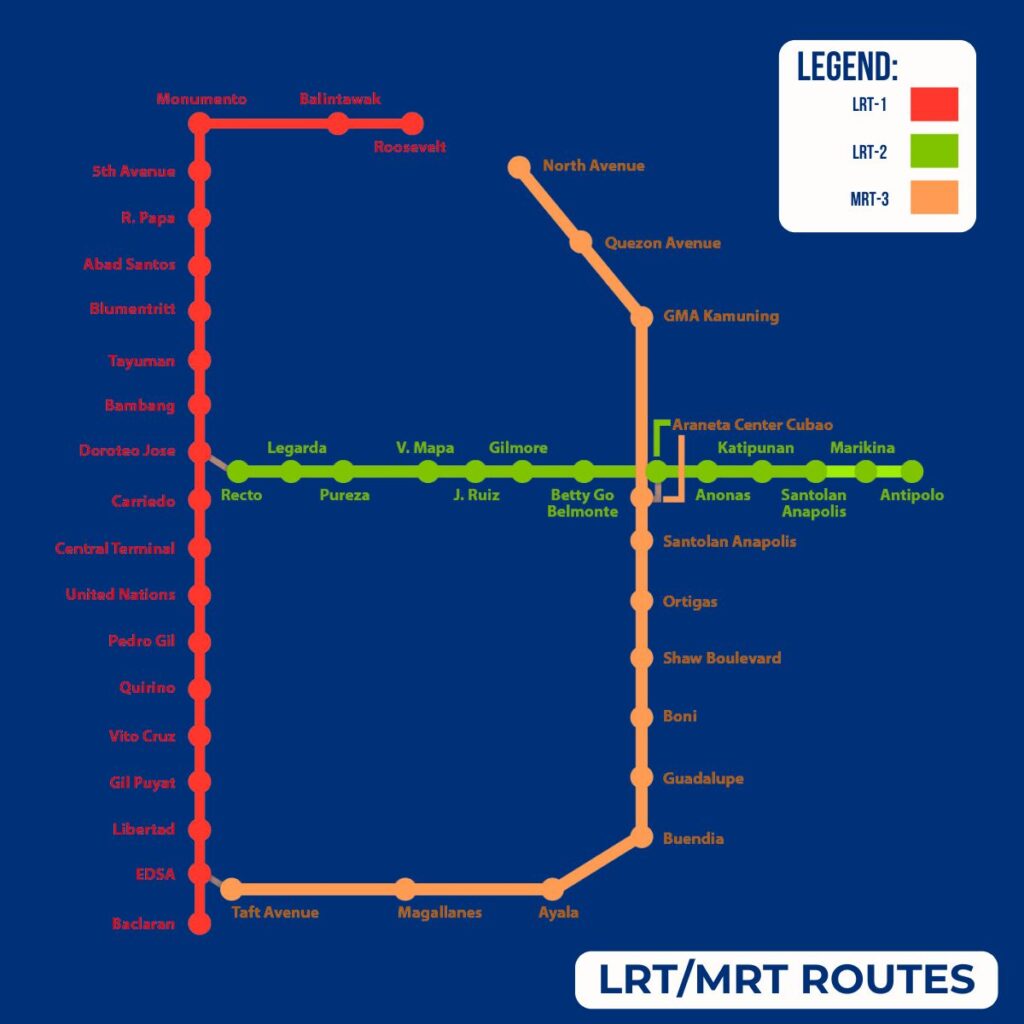
Metro Manila commuters are the primary users of the transit system, commonly referred to as MRT. Its sole operating line is the MRT-3, which opened in 1999. Although the government has already purchased new trains to accommodate the increasing number of daily passengers, another MRT line is currently being built.
Metro Rail Transit Line 3 (MRT-3)
The north and south of Metro Manila are the main destinations served by this 16-kilometer train system. Learn to navigate the MRT’s thirteen stops to ensure a safe and enjoyable ride:
Quezon City
- North Avenue
- Quezon Avenue
- GMA Kamuning
- Araneta Center-Cubao
- Santolan-Annapolis
Pasig City
- Ortigas Avenue
Mandaluyong City
- Shaw Boulevard
- Boni Avenue
Makati City
- Guadalupe
- Buendia
- Ayala
- Magallanes
- Taft Avenue
Tickets range from Php 13 to Php 28 depending on your destination.
Operating Hours
MRT-3 operates commercially from Monday to Sunday. Operating hours are subject to change, particularly on holidays and in severe weather. Please refer to the quick guideline below for what time the MRT usually open:
North Avenue
4:36 AM — First trip
9:30 PM — Last trip
Taft Avenue
5:18 AM — First trip
10:11 PM — Last trip
Also Read: Metro Manila Subway Project on the works
Light Rail Transit (LRT)
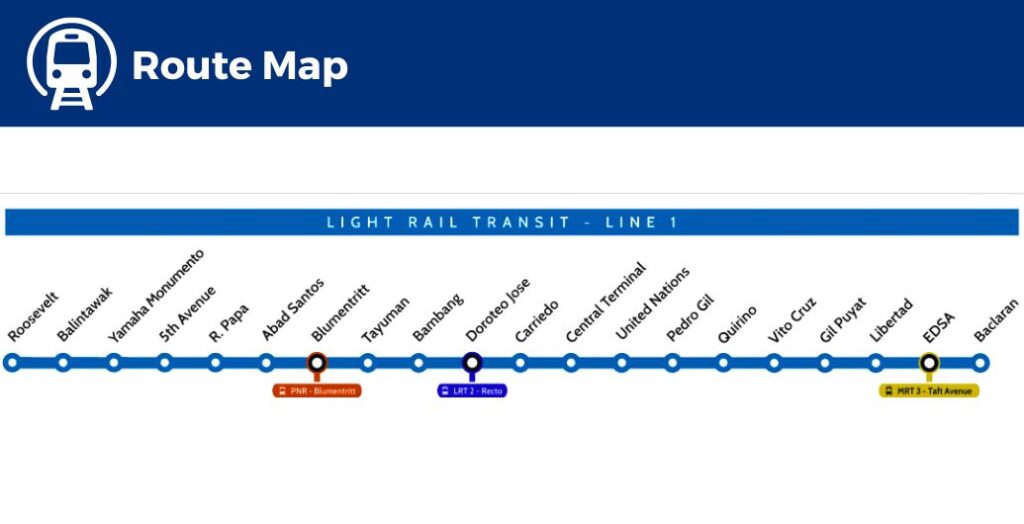
The LRT, or light rail transit, system is made up of two active lines: LRT-1 and LRT-2. Over 100,000 passengers use both LRT lines every day, which has forced the government to purchase additional light rail vehicles.
LRT-1
LRT-1 connects the cities of Pasay and Caloocan with 113 trains, with a daily ridership estimated at half a million. Below are its 20 stations.
- Baclaran
- EDSA
- Libertad
- Gil Puyat
- Vito Cruz
- Quirino
- Pedro Gil
- UN Avenue
- Central Terminal
- Carriedo
- Doroteo Jose
- Bambang
- Tayuman
- Blumentritt
- Abad Santos
- R. Papa
- 5th Avenue
- Monumento
- Balintawak
- Roosevelt
With regards to how much the LRT fare depends on your destination, but usually would cost from Php 15 to Php 30.
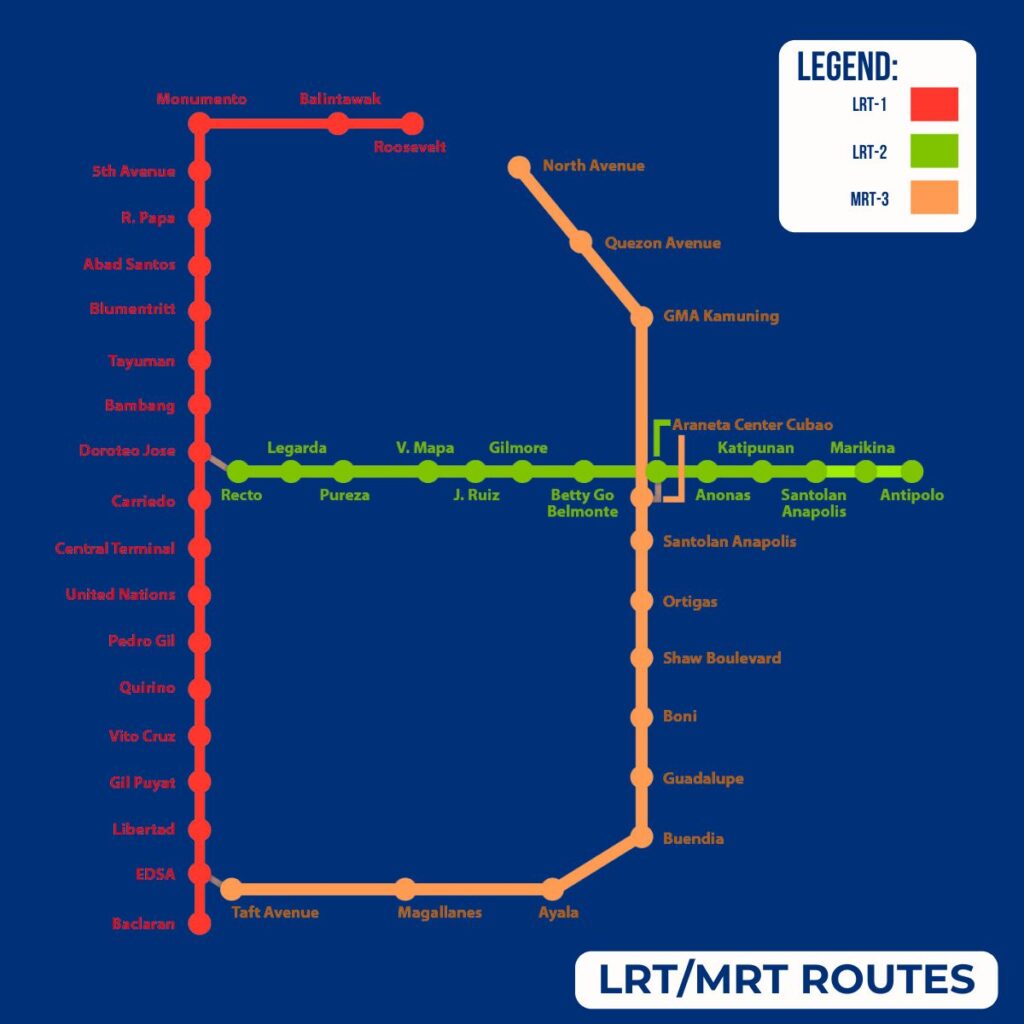
LRT-2
More than 200,000 people use it every day to link Pasig and Manila. Below are its 13 stations.
- Antipolo
- Marikina
- Santolan
- Katipunan
- Anonas
- Cubao
- Betty Go Belmonte
- Gilmore
- J. Ruiz
- V. Mapa
- Pureza
- Legarda
- Recto
Tickets for LRT-2 range from Php 15 to Php 30.
Operating Hours
The LRTA has established the following hours of operation, which include holidays and weekends. Any modifications will be periodically announced. Regular operating hours are listed below.
- 5:00 AM — the start of commercial operations (in both directions)
- 8:30 PM — the last commercial train departs from Antipolo Station to Recto Station
- 9:00 PM — the last commercial train departs from Recto Station to Antipolo Station
A single-journey ticket or reloadable Beep card (stored value ticket) are available. As a stored-value contactless card, commuters may pay for LRT1, LRT2, and MRT3 fares, P2P buses, PUVs, Cebu Ferries, convenience stores, and partner merchants. On how to ride the LRT in Manila, first, you’ll need to purchase a ticket from the station’s ticket booth or vending machines.
Philippine National Railways (PNR)
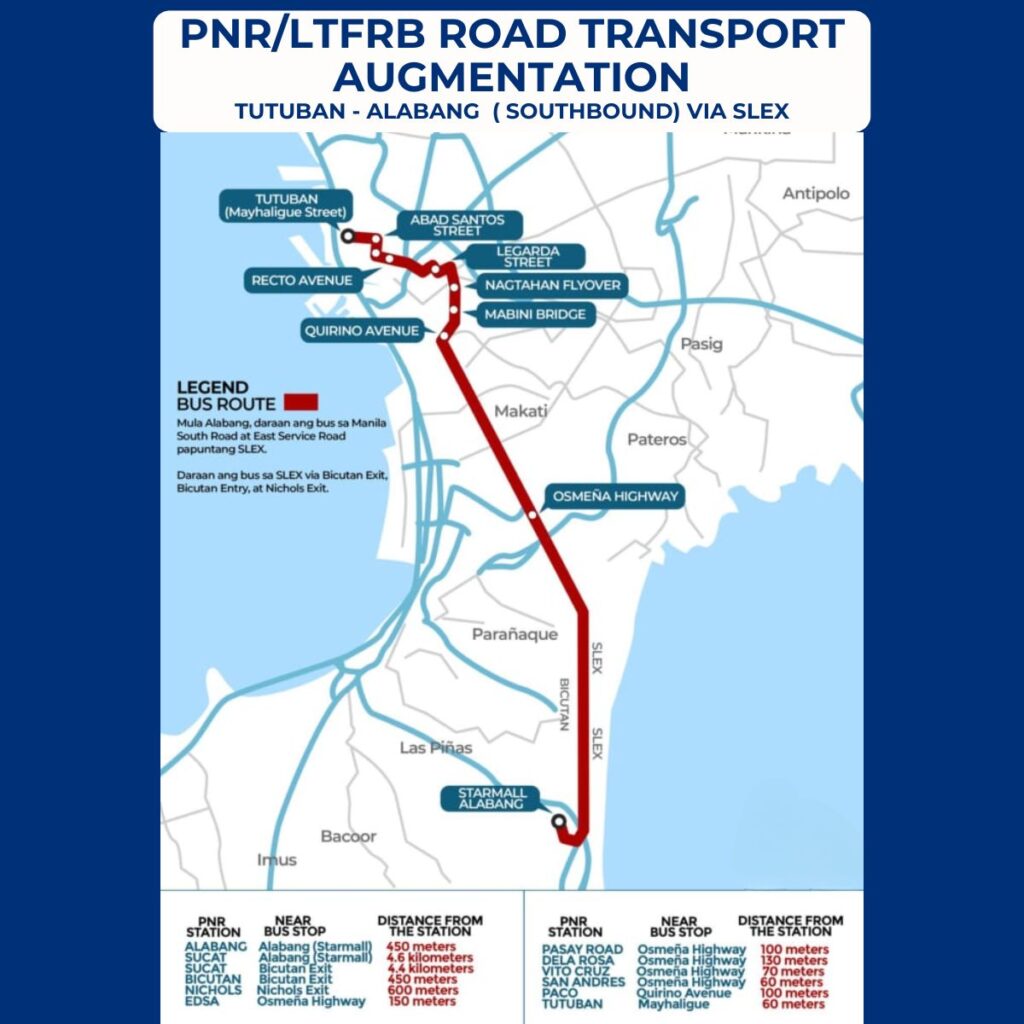
This Philippine National Railways train system has two metro commuter lines, Metro South and Metro North. Both commuter lines intersect at Tondo’s Tutuban station. If you’re unfamiliar with what the Philippine National Railways is, it’s the state-owned railway system that serves various parts of the country, offering both commuter and long-distance services.
Here are six stations in the Metro North Commuter Line:
- Tutuban
- Solis
- C-3
- Asistio Avenue
- Caloocan/Sangandaan
- Governor Pascual
Here are 17 stations in the Metro South Commuter Line:
- Tutuban
- Blumentritt
- Laon Laan
- España
- Sta. Mesa
- Pandacan
- Paco
- San Andres
- Vito Cruz
- Buendia
- Pasay Road
- EDSA
- Nichols
- FTI
- Bicutan
- Sucat
- Alabang
Tickets for PNR range from Php 15 to Php 30.
Operating Hours
The following are the operating hours set by the PNA: open through Sunday till Saturday and holidays. Any changes will be announced periodically. The regular operating hours are listed below.
- 5:30 AM — the start of commercial operations (in both directions)
- 8:03 PM — the last commercial train departs from Alabang Station to Tutuban Station
Also Read: DPWH announces repair of Northbound Roxas Boulevard-EDSA Flyover
Frequently Asked Questions (FAQs)
How do I pay for my LRT?
You can purchase a single-journey ticket or use a reloadable Beep card to pay for your LRT fare.
How much is the LRT fare now?
LRT fares range from Php 15 to Php 30, depending on your destination.
What is the meaning of Philippine National Railways?
The Philippine National Railways (PNR) is a train system in the Philippines that operates metro commuter lines known as Metro South and Metro North. It serves commuters traveling in both directions, intersecting at Tutuban station.
How do you travel in MRT?
To travel on the MRT, buy a single-journey ticket or use a reloadable Beep card for contactless payment.
How to buy an MRT ticket in Manila?
To purchase an MRT ticket in Manila, you can visit the ticketing booths at MRT stations. Line up, specify your destination, and pay the corresponding fare. Alternatively, you can use a reloadable Beep card for quicker transactions.
Final Thoughts
Newcomers may find Manila’s MRT, LRT, and PNR confusing, but understanding the routes, stops, and ticket alternatives is essential. Over 100,000 passengers use the LRT-1 and LRT-2 to connect various cities, while the MRT-3 serves north and south Metro Manila with thirteen stops. Tutuban station connects Metro South and Metro North, two essential metro commuter lines on the PNR. Understanding ticketing, rates, and operation hours makes the trip easier, whether using single-journey tickets or reloadable Beep cards. Knowing these details makes navigating Manila’s busy train system easier, improving residents’ and visitors’ commutes.
Keep Reading:How to Commute in Manila as a First Timer (Public Transport Guide)
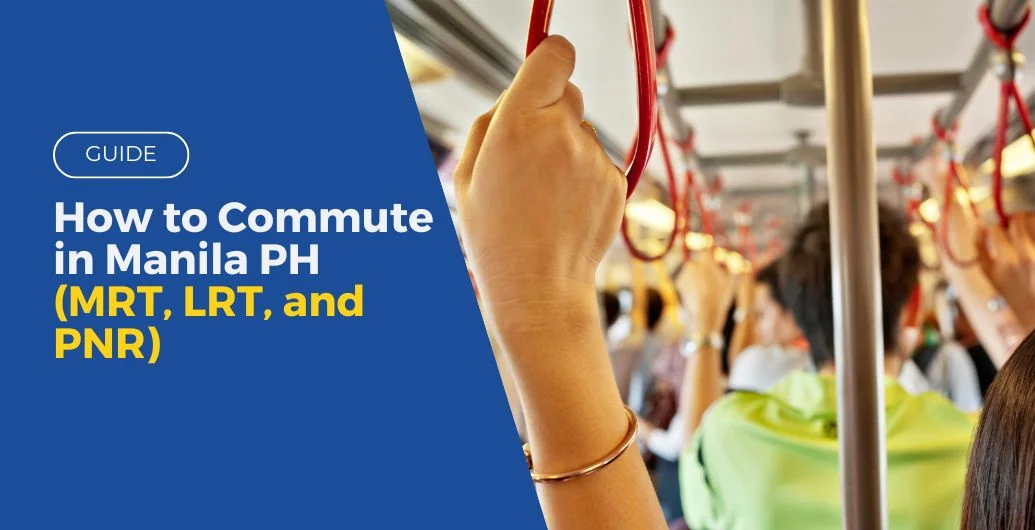
Leave a Reply